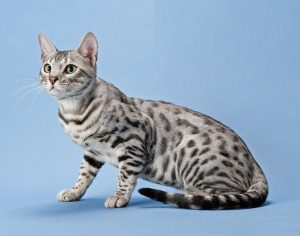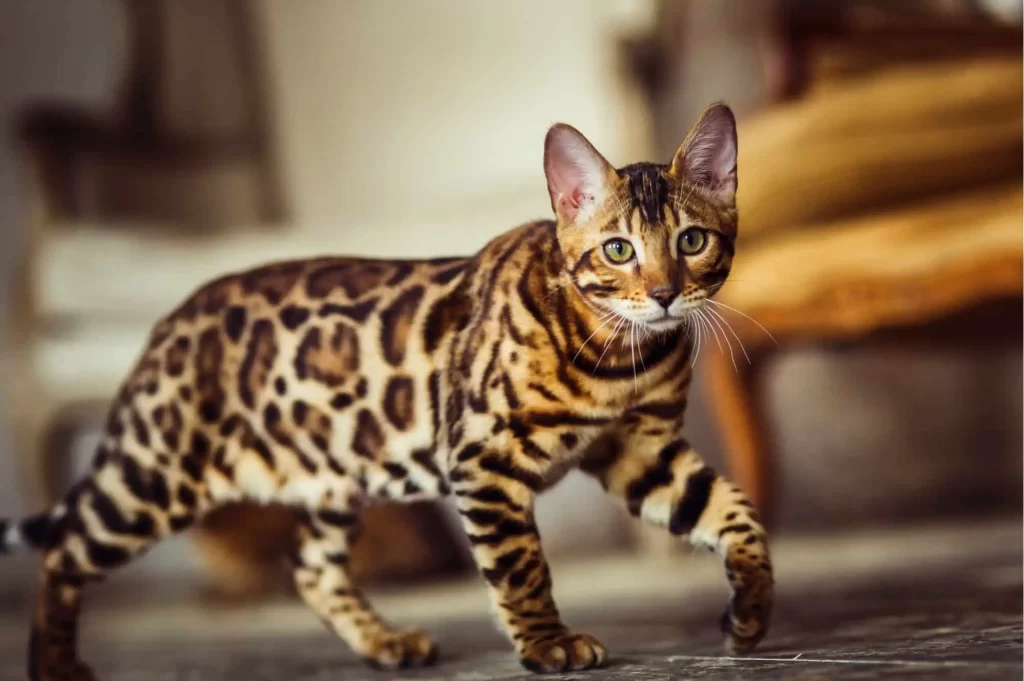Bengal cats are captivating and unique felines. If you’re considering adopting a Bengal cat, you’ll have a delightful and exotic companion!
Fascinating details
Appearance
- Bengal cats have a wild and striking appearance, resembling their distant ancestors, the Asian leopard cats.
- They come in various coat patterns, including spotted or marbled.
- Coat colors range from brown tabby to seal sepia tabby, and more.
- Their eyes can be green or gold.
- These cats typically weigh around 12 pounds and have a length of up to 18 inches.
- While they look wild, they remain about the same size as a large domestic house cat.
Personality
- Bengals are affectionate, playful, and energetic.
- They get along well with people of all ages and other pets.
- If you adopt a Bengal, be prepared for an active and lively companion.
History
- The Bengal cat hybrid was developed in the 1970s by crossing Asian leopard cats with domestic cats like the Abyssinian, Egyptian Mau, or American shorthair.
- Jean Sudgen Mill and others played a crucial role in creating this breed.
- The generations away from their wild ancestry are denoted by F1, F2, and F3. By F3, Bengal cats exhibit the temperaments of domestic cats.
- To be shown, the International Cat Association (TICA) accepts only cats of F4 or more generations removed from having an African leopard cat (ALC) ancestor.
Health and Care
- Bengal cats can live up to 15 years.
- They are not hypoallergenic.
- Regular grooming and playtime are essential for their well-being.

Health issues
While Bengal cats are generally healthy, there are a few health issues specific to this breed that owners should be aware of:
Hypertrophic Cardiomyopathy (HCM)
- HCM is a common heart condition in Bengal cats.
- Regular veterinary check-ups are crucial to monitor heart health.
- Early detection and management are essential.
Progressive Retinal Atrophy (PRA)
- PRA is an inherited condition that affects the retina.
- It can lead to gradual vision loss.
- Responsible breeding practices can help reduce the risk.
Flat-Chested Kitten Syndrome (FCKS)
- Some Bengal kittens may develop a flat chest due to weak cartilage.
- Proper nutrition and supportive care are necessary for affected kittens.
Patellar Luxation
- This condition involves the kneecap slipping out of place.
- Regular exercise and maintaining a healthy weight can help prevent it.
Bengal Nose
- Some Bengals have a pink or partially pink nose.
- While it’s not a health issue, it’s a unique trait.
- Remember to provide your Bengal cat with a balanced diet, regular exercise, and routine veterinary visits to ensure their well-being!
How to take care of Bengal Cats
Bengal cats are delightful companions, and proper care ensures their well-being. Here are some essential guidelines for taking care of your Bengal cat:
Diet and Nutrition
- High-quality cat food: Choose a balanced diet specifically formulated for cats. Look for options that include real meat as the primary ingredient.
- Protein: Bengals thrive on protein-rich diets. Ensure their food contains adequate protein.
- Fresh water: Always provide fresh water for your cat.
Grooming
- Regular brushing: Bengal cats have short, dense fur. Brush them weekly to remove loose hair and prevent matting.
- Nail trimming: Trim their nails regularly to avoid overgrowth and scratching.
- Oral hygiene: Brush their teeth to prevent dental issues.
Exercise and Play
- Bengals are energetic. Engage them in playtime with interactive toys, feather wands, and puzzle feeders.
- Provide vertical space like cat trees or shelves for climbing and exploring.
Litter Box Maintenance
- Keep the litter box clean. Bengals are particular about hygiene.
- Use a high-quality clumping litter.
Healthcare
- Regular vet visits: Schedule annual check-ups and vaccinations.
- Parasite control: Keep up with flea, tick, and worm prevention.
- Spaying/neutering: Consider this for health and population control.
- Microchipping: Ensure your Bengal is microchipped for identification.
Social Interaction
- Bengals are social cats. Spend time with them daily.
- They enjoy interactive play and may even learn tricks.
Environmental Enrichment
- Provide stimulating environments with scratching posts, hiding spots, and cozy beds.
- Rotate toys to keep them engaged.
Safety
- Indoor living: Bengals are best kept indoors to protect them from dangers like traffic and predators.
- Secure windows and balconies to prevent escapes.
Remember, each Bengal cat has its unique personality, so adapt your care routine to suit their preferences. Enjoy the playful antics and companionship of your Bengal!
Lifespan
The lifespan of a Bengal cat can vary based on several factors, but on average, they live between 12 to 15 years. Proper care, regular veterinary check-ups, and a healthy lifestyle can contribute to a longer and happier life for your Bengal companion.

You might also be interested in:

